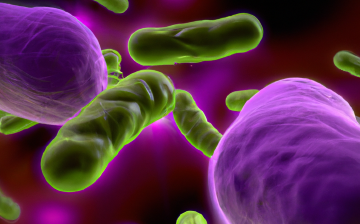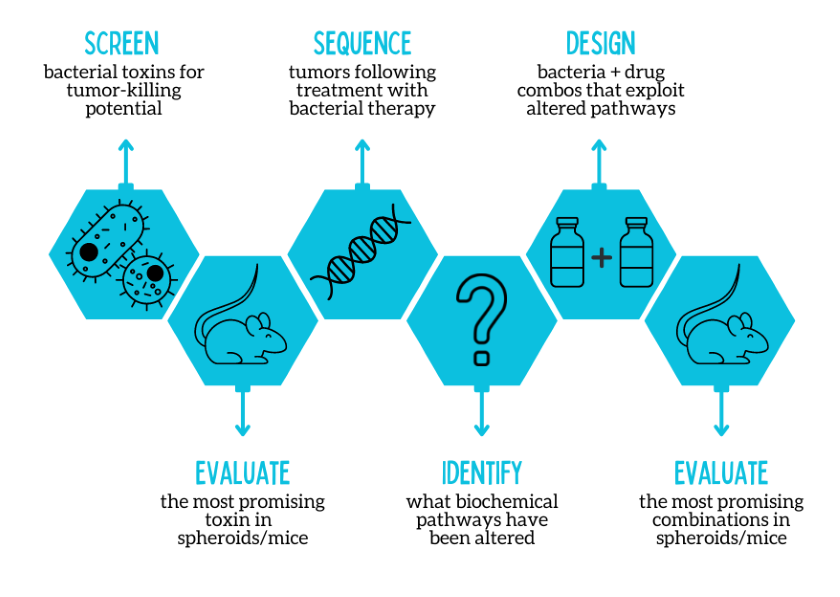Preclinical pipeline could identify novel therapeutic combinations for lung tumors
It may come as a surprise, but bacteria love to grow inside tumors. It’s the environment—tumors are typically acidic, have low amounts of oxygen, and are filled with dead cells, which all facilitate bacterial growth. Perhaps more importantly, the immune system can’t easily find and destroy microbes in the tumor core, giving bacteria a safe harbor to grow. This represents a therapeutic advantage: bacteria can be used to target cancerous tissues, penetrating deep into the tumor, where they can be engineered to release a therapeutic payload that kills cancer cells.

So why aren’t more cancer treatments incorporating engineered bacteria? One of the main issues is identifying which bacterial therapy would be the most effective for a specific cancer type, which is a daunting and time-consuming task. Bacteria can shape how tumors grow and survive, and finding existing therapeutics that exploit these changes could lead to novel treatment combinations for hard-to-treat tumor types.
Now, researchers from Columbia University's School of Engineering and Applied Science are developing a pipeline to systematically evaluate how bacterial treatments might synergize with existing anti-cancer therapies. Their study, recently published in Nature Scientific Reports, used this pipeline to evaluate treatment combinations in preclinical models of non-small cell lung cancer, which account for roughly 80% of all lung cancers.
“Lung cancers are a logical test case for bacterial treatments, as these tumors have been shown to harbor several different bacterial strains,” explained first study author Dhruba Deb, Ph.D., an associate research scientist at Columbia. “While we chose to focus on non-small cell lung cancer in our study, our pipeline could easily be adapted to focus on other cancer types.”
Bacterial treatments have two important components: the type of bacteria that is used (like E. coli, for example), and the cargo that the bacteria are engineered to produce, such as a toxin or other anticancer agent, which can destroy cells. Both of these components can be modified to make bacterial treatments safer and more effective at killing cancer cells. The bacterial strain can be engineered to only grow in specific environments, or to release its cargo only in the presence of a specific molecule, which results in controlled drug release inside of tumors. The bacterial cargo can be designed or chosen so that it effectively kills specific types of cells.
In this study, the researchers used a bacterial strain that had been previously engineered to release its cargo on demand, along with other modifications that made it less toxic. In terms of therapeutic cargo, the researchers focused on different types of bacterial toxins. The first step in their pipeline was to identify which toxin had the best tumor-killing potential for non-small cell lung cancer. The researchers screened 10 bacterial toxins and found that theta toxin, a compound that pokes holes in cell membranes, was the most effective at killing the lung cancer cells. When the researchers treated a mouse model of non-small cell lung cancer with bacteria engineered to release theta toxin, the lung tumors markedly shrank, and there were no signs of damage to other organs.
Next, the researchers wanted to understand if the bacterial treatment was affecting the underlying biology of the lung tumors. “Cancer cells can evolve so that they can better survive anti-cancer treatments,” explained senior study author Tal Danino, Ph.D., an associate professor at Columbia. “If lung cancer cells become dependent on specific biochemical pathways for their survival following bacterial therapy, blocking these pathways with existing anti-cancer drugs could eliminate the cancer cells more efficiently than either treatment approach alone,” Danino said.

Using a next-generation sequencing approach, the researchers were able identify which biochemical pathways were altered because of the bacterial therapy. Theta toxin, it turns out, affects specific pathways in lung cancer cells, such as those that control cell growth or DNA repair. By focusing on existing drugs that target these pathways, the researchers could more efficiently screen current anti-cancer drugs that might synergize with bacterial therapy.
After narrowing down therapy combinations and evaluating them in tumor spheroids, the researchers evaluated the most promising combination in a mouse model of lung cancer. They found that mice treated with the combination therapy had the greatest reduction in tumor growth compared with mice treated with just one component of the treatment (either bacterial therapy or a drug that targets cell growth) alone.
“By incorporating next-generation sequencing methods and tumor spheroids, our pipeline could allow for accelerated identification and evaluation of combinatorial treatments for lung cancer that incorporate bacterial therapy,” said Deb. “Globally, there are ~700 lung cancer therapies that are in various stages of preclinical and clinical trials. Our study opens up the possibility to pick and choose from this large repertoire of cancer drugs to selectively combine with bacterial therapy for a precision medicine approach.”
“Engineered bacteria for cancer treatment represents an untapped area of drug development,” said David Rampulla, Ph.D., director of the division of Discovery Science & Technology at NIBIB. “This study outlines a potential way to expedite the translation of bacterial therapies to the clinic, which could ultimately improve the efficacy of existing anti-cancer treatments.”
The researchers noted that humans are ~250 times more sensitive to bacteria than mice are, and that further modifications to bacterial strains will likely be needed to keep this approach safe for human patients.
This study was supported by a grant from NIBIB (R01EB029750).
This Science Highlight describes a basic research finding. Basic research increases our understanding of human behavior and biology, which is foundational to advancing new and better ways to prevent, diagnose, and treat disease. Science is an unpredictable and incremental process—each research advance builds on past discoveries, often in unexpected ways. Most clinical advances would not be possible without the knowledge of fundamental basic research.
Study reference: Deb, D., Wu, Y., Coker, C. et al. Design of combination therapy for engineered bacterial therapeutics in non-small cell lung cancer. Sci Rep 12, 21551 (2022). https://doi.org/10.1038/s41598-022-26105-1
